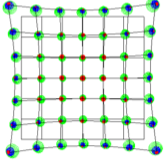
OPTICS: Simulation of Electron and Ion Beam Columns
This software package is for computing the optical properties of complete electron and ion beam columns, containing any combination of electrostatic and magnetic lenses and deflectors. The program computes all the optical properties and rotationally symmetric and multipole geometrical aberrations of third order, and all the chromatic aberrations of first order using paraxial rays and aberration integrals. The software can handle both Gaussian round beam systems and shaped beam systems, and the fields of the various elements can be superimposed on each other.




The software is a comprehensive package and has recently been enhanced to incorporate a graphical user interface (GUI) that operates under the latest Microsoft Windows Operating systems.
If you are interested in the OPTICS package, please contact us at info@electronoptica.com.
Spot diagram across scan field.
Equipotentials of 1st harmonic field.
Potential distribution in an electrostatic lens.
Flux distribution in a magnetic lens.
